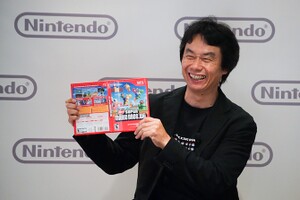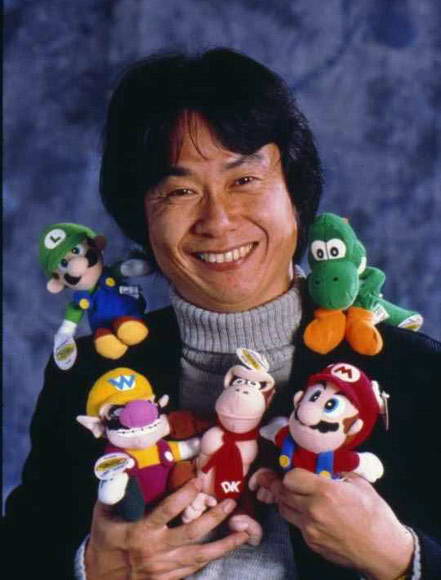Shigeru Miyamoto
- “What if, on a crowded street, you look up and see something appear that should not, given what we know, be there. You either shake your head and dismiss it, or you accept that there is much more to the world than we think. Perhaps it really is a doorway to another place. If you choose to go inside you may find many unexpected things....”
- —Shigeru Miyamoto
Shigeru Miyamoto (November 16, 1952 - ) is the man who invented Mario, The Legend of Zelda, Star Fox, Pikmin and F-Zero Series. He rides his bike, or walks to work each day, usually with his wife, whom he met on the job (She was a general manager for his current occupation). He joined the industry as a designer for character art in 1977. He has worked on many famous Mario games, and the well-known Japanese version of Super Mario Bros. 2, Doki Doki Panic.
In his early childhood, he was raised in the small, rural town of Sonobe, Japan; which was near his current home of Kyoto, about ten blocks from Nintendo headquarters. His home lacked a television, so he would spend a large amount of his time exploring the surrounding countryside. One time, he discovered a large series of caves. He returned with a lantern and spent the summer spelunking.
Miyamoto wanted to make things that would astonish the world. He considered becoming a puppeteer, a painter, and later made toys. He decided to study industrial design at Kanazawa Munici College of Industrial Arts and Crafts in 1970. He only attended class half the time, so it took him five years to graduate.
Miyamoto was 24, and had shaggy hair when he had his father contacted an old toy company friend, named Hiroshi Yamauchi. The company's name was Nintendo. Yamauchi requested to see some toy designs, to which Miyamoto responded to by returning with a bag of goodies, and an amazing portfolio. Miyamoto became Nintendo's first staff artist in 1977.
Three years later, in 1980, Nintendo of America was looking for a hit to establish themselves in the arcade market. They ordered a large number of units of an arcade game called Radar Scope, but by the time the machines arrived, the interest in the game had bombed. Nintendo needed a game that the machines could be converted into easily. Yamauchi called Miyamoto into his office, as he was the only staff member available at the time. He questioned Miyamoto about his knowledge on this new concept. Miyamoto claimed to have loved video games in college. After some licenses fell through, Donkey Kong was born.
With Donkey Kong's success, Miyamoto was given his own team: R&D 4, later known as Nintendo EAD. They would go on to make some of Nintendo's most memorable games, including Mario.
Despite being an influential figure in video games and responsible for multi-million dollar franchises, Miyamoto is said to be very humble, insisting on settling for an average income.
Awards and Honors

- The first ever Inductee to the Academy of Interactive Arts and Sciences Hall of Fame
- A star on the Walk of Game
- French Order of Arts and Literature
- Featured in Time Asia's "60 Years of Asian Heroes"
- GDC's Lifetime Achievement Award
- Subject of an episode of Icons
Trivia
- Miyamoto is ambidextrous. He favors his left hand and likes to make characters that are left-handed. For example, Bowser Jr. and Link are left-handed.
- Miyamoto can play both the guitar and banjo.
- He starred in a Mega 64 sketch about New Super Mario Bros.
- When Shigeru was in Elementary School, he wanted to be involved in puppet shows and wanted to make puppets, design sets, and write stories for puppet shows.
- Shigeru Miyamoto has been openly referred to by Mario in the game Mario Vs. Donkey Kong.
- In Donkey Kong 64 level "Frantic Factory" there is a part of the level called "R&D"; this might be a reference to R&D 4.
Inspiration
Shigeru takes much of his ideas for his games from folklore, books, popular TV series but also much from his own experiences as a kid. For example: the the warpzones in SMB comes from Star Trek. The Super Mushrooms comes from Alice in the Wonderland. The dungeons in the Zelda games was inspired by his Family's in Sonebe with it's many sliding doors and maze like design. His memory of his parent's attic which he often used as a haven has inspired him to create many of the safe places in his Mario games. His games encourages the players to explore and try to find new secret areas by rewarding them when they do find one. If there's one thing the Mario and Zelda games are famous for, it's all their secrets!
Quotes
Template:LLQuoteTemplate:Refneeded
Template:LLQuoteTemplate:Refneeded
References
- ^ Interview in Mario Mania guide, p. 31
- ^ David Doñas Salinas Metroide, Por. (2002) Biografía Shigeru Miyamoto (Spanish), translated. Retrieved on 2008-8-22
External links
- Miyamoto Shrine: A website dedicated to Shigeru Miyamoto
- Retro Nintendo's Scan
- Gamehiker
